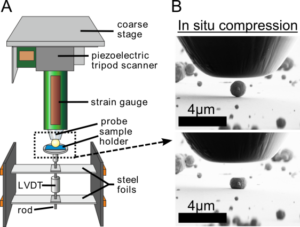Jonas Paul
Dr.-Ing. Jonas Paul
Project description
Former project: Effect of surface properties on adhesion and friction of particle systems
Project area: B2
Supervisor: Prof. Dr.-Ing. Wolfgang Peukert
Granular matter in form of powders has widespread application in process engineering and various adjacent fields. The macroscopic properties of the particle systems are determined by the microscopic properties of the single particles. However, fundamental mechanisms of particle interactions are still not fully understood. In particular, many physical and chemical mechanisms at small particle distances (of a few nm) and their effect on the contact mechanics are still unknown. The predictive calculation of contact forces and tribological processes are just possible in few specific cases.
The project focused on an improved understanding of mechanisms in the contact area of particulate systems. The mechanical, tribological and adhesive properties of single particles in the size range 0.2-10 µm were studied with specially developed in-situ techniques giving unique insight into the contact mechanics between particles. The elastic-plastic deformation behavior of single micro- and nanoparticles under mechanical stress as well as their adhesive and tribological behavior as a function of material and system parameters were investigated. The systematic studies of the adhesive, frictional and deformation behavior of single particles dependent on material properties, particle size, roughness and physical/chemical surface properties yielded fundamental insights into basic mechanisms occurring between particles in contact and provided data for a physically based modelling of these processes. Therefore SEM- and TEM-supported mechanical micro- and nanomanipulation (Fig. 1) [1–3], static and dynamic force spectroscopy by scanning probe technics [4] and surface sensitive non-linear optical spectroscopy [5] were applied. From the theoretical side, new analytical approaches were developed [6] in combination with continuum mechanical FEM-simulations of deformation (Fig. 2) [7].

Fig. 1: (A) Schematic illustration of the custom built manipulation device used for in situ compression experiments of sub-micron particles inside a SEM. (B) SEM image of the contact configuration of an unstressed and stressed gold particle.

Fig. 2: (A) Measured engineering stress σ as a function of strain of the compression of various gold particles and corresponding FEM data for frictional and frictionless contacts. (B) Plastic energy density distributions inside a gold particle determined from the frictionless and frictional FE model.
References
[1] S. Romeis et al., Rev. Sci. Instrum. 83 (2012) 095105.
[2] S. Romeis et al., Part. Part. Syst. Charact. 31 (2014) 664.
[3] J. Paul et al., Powder Technol. 270 (2015) 337.
[4] J. Paul et al., Langmuir 32 (2016) 8298.
[5] C. Meltzer et al., J. Am. Chem. Soc. 136 (2014) 10718.
[6] J. Paul et al., Adv. Powder Technol. 25 (2014) 136.
[7] J. Paul et al., Powder Technol. 286 (2015) 706.

